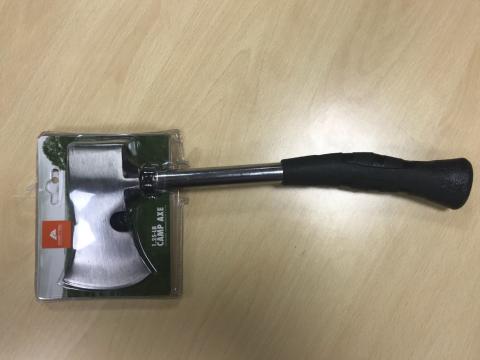Name of product:
Ozark Trail camp axes
Hazard:
The axe head can detach from the handle, posing an injury hazard.
Remedy:
Refund
Recall date:
October 3, 2018
Units:
About 246,000
Consumer Contact:
Walmart at 800-925-6278 from 7 a.m. through 9 p.m. CT any day or online at www.walmart.com and click on "Product Recalls" for more information..
Recall Details
Description:
This recall
involves Ozark Trail camp axes. The steel shaft tubular axes measure
about 14 inches long from handle to axe head, and weigh about 1.25 lbs.
The axes have a black, non-slip rubber grip and claw feature. “Ozark
Trail” and model number 60111140 are printed on the product packaging.
Remedy:
Consumers should immediately stop using the recalled axes and return them to Walmart for a full refund.
Incidents/Injuries:
Walmart has received two reports of axe heads detaching from the handle, resulting in minor cuts and abrasions.
Sold Exclusively At:
Walmart stores nationwide and online at www.walmart.com from January 2017 through July 2018 for about $8.
Manufacturer(s):
Gardex, of India
Importer(s):
Walmart Inc., of Bentonville, Ark.
Distributor(s):
Walmart Inc., of Bentonville, Ark.
Manufactured In:
India
Recall number:
19-003
The U.S. Consumer Product Safety Commission is
charged with protecting the public from unreasonable risks of injury or
death associated with the use of
thousands of types of consumer products under the agency’s
jurisdiction. Deaths, injuries, and property damage from consumer
product incidents cost the
nation more than $1 trillion annually. CPSC is committed to
protecting consumers and families from products that pose a fire,
electrical, chemical or
mechanical hazard. CPSC's work to help ensure the safety of
consumer products - such as toys, cribs, power tools, cigarette lighters
and household
chemicals -– contributed to a decline in the rate of deaths
and injuries associated with consumer products over the past 40 years.
Federal law bars any person from selling products subject to a publicly-announced voluntary recall by a manufacturer or a mandatory recall ordered by the Commission.
To report a dangerous product or a product-related injury go online to www.SaferProducts.gov or call CPSC's Hotline at 800-638-2772 or teletypewriter at 301-595-7054 for the hearing impaired. Consumers can obtain news release and recall information at www.cpsc.gov, on Twitter @USCPSC or by subscribing to CPSC's free e-mail newsletters.
Federal law bars any person from selling products subject to a publicly-announced voluntary recall by a manufacturer or a mandatory recall ordered by the Commission.
To report a dangerous product or a product-related injury go online to www.SaferProducts.gov or call CPSC's Hotline at 800-638-2772 or teletypewriter at 301-595-7054 for the hearing impaired. Consumers can obtain news release and recall information at www.cpsc.gov, on Twitter @USCPSC or by subscribing to CPSC's free e-mail newsletters.




























